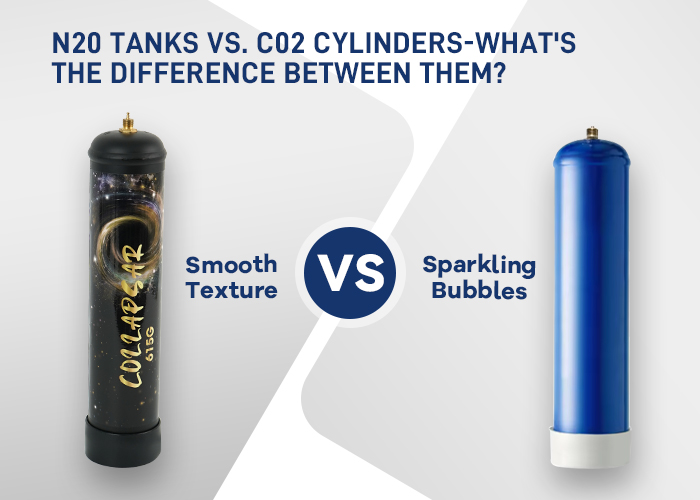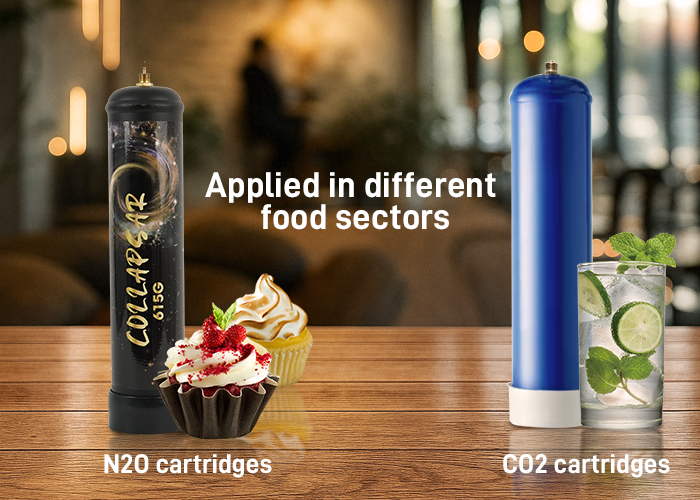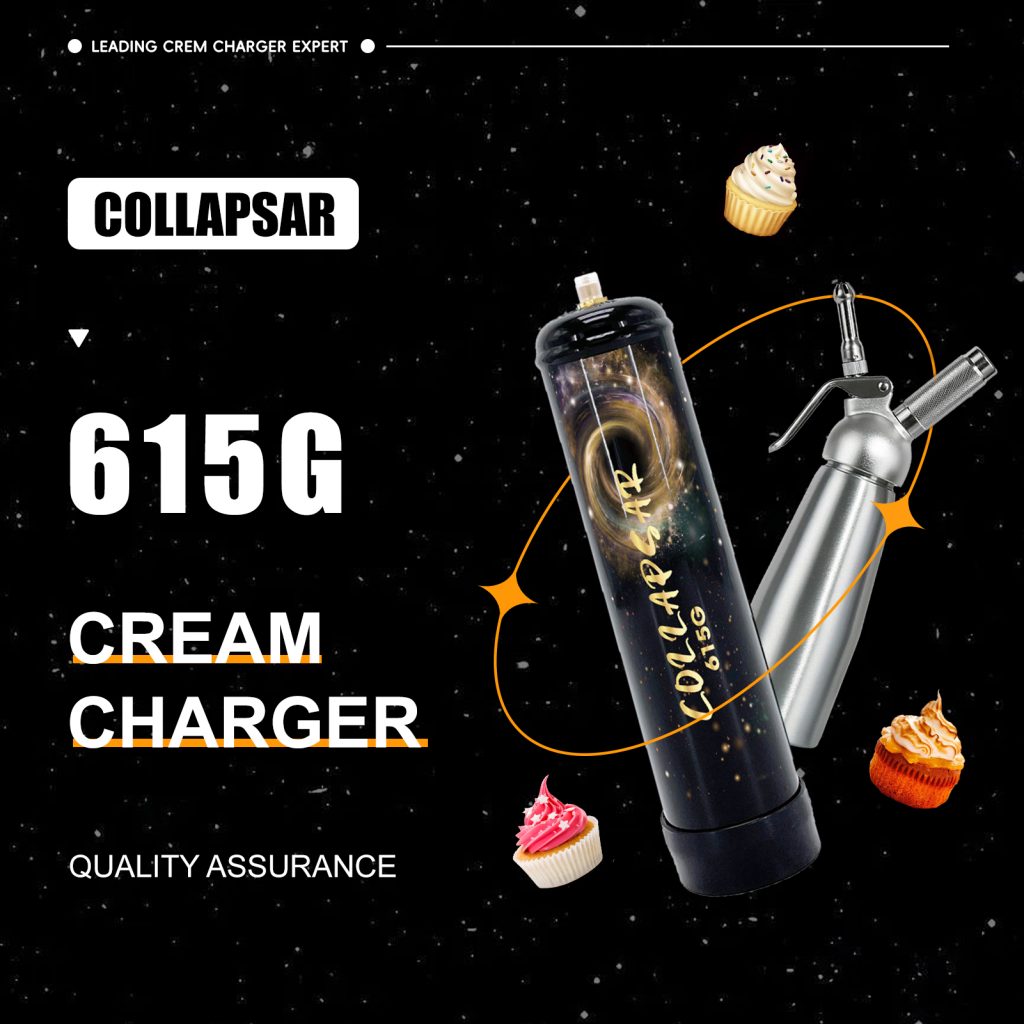In the world of compressed gases, two common options might seem similar at first glance. These pressurized containers serve different purposes across various culinary applications. Understanding their unique characteristics is crucial for achieving the best results.
While both types of gas cylinders appear similar in form, they contain distinct gases designed for specific tasks. The choice between them significantly impacts the outcome of your culinary creations. This knowledge is essential for everyone from professional chefs to home cooking enthusiasts.
This guide will explore the key areas of comparison. We will cover gas composition, primary applications, and important safety considerations. Making an informed decision enhances both safety and the quality of your final product.
COLLAPSAR stands as a trusted provider of premium nitrous oxide products. The company is committed to food-grade purity and customer satisfaction for all culinary applications.
Key Takeaways
- Two main types of pressurized containers are used in cooking, each with a different purpose.
- The gas inside the cylinder determines its function and final result.
- Selecting the correct option is vital for safety and achieving desired culinary outcomes.
- Key differences include the gas used, applications, and technical specifications.
- COLLAPSAR provides high-quality solutions specifically designed for food preparation.
- This guide will help you choose the right product for your specific needs.
Introduction: The Role of Gas Cartridges in Culinary Innovations
The modern kitchen has been reshaped by the power of pressurized gases, unlocking textures and flavors once reserved for high-end restaurants. These small, sturdy cylinders are essential for various culinary applications. They allow both professional chefs and home cooks to achieve remarkable results with ease.
Culinary Transformations and Modern Applications
These tools revolutionize simple ingredients. Heavy cream becomes a light, stable foam. Still water turns into a sparkling beverage. This technology is a cornerstone of modern gastronomy.
It enables the creation of airy mousses and innovative espumas. The key is using the correct gas for the specific task. Each type serves a unique and vital purpose.
An Overview of Gas Types in the Kitchen
Understanding the different gases is crucial for success. One gas excels at foaming fatty liquids like cream. Another is perfect for carbonating water-based drinks.
They are designed for distinct applications and are not interchangeable. Using the right one ensures food safety and optimal performance. The following table highlights their primary uses:
| Gas Type | Primary Function | Common Device | Resulting Product |
|---|---|---|---|
| Nitrous Oxide (N2O) | Creates stable foams and whipped textures | Whipped Cream Dispenser | Fluffy whipped cream, mousses |
| Carbon Dioxide (CO2) | Carbonates liquids | Soda Siphon | Sparkling water, carbonated beverages |
Selecting the appropriate product is fundamental. It guarantees consistency and quality in all your culinary creations.
CO2 Cartridges vs N2O Cartridges: Defining Characteristics
At their essence, these pressurized containers differ dramatically in composition, pressure, and intended functionality. The key differences begin with the fundamental chemical properties of each gas.
Gas Composition and Technical Specifications
Nitrous oxide consists of two nitrogen atoms bonded to one oxygen atom. This N2O gas dissolves readily in fatty substances, making it ideal for culinary foams.
Carbon dioxide contains one carbon atom and two oxygen atoms. CO2 excels at dissolving in water-based liquids for carbonation purposes.
Pressure, Volume, and Performance Differences
The operating pressure creates a major distinction. Nitrous oxide systems work at 50-60 bar, while carbon dioxide operates at 10-12 bar.
Standard cream chargers hold approximately 8 grams of N2O. CO2 containers range from 8-16 grams depending on size. These technical specifications determine equipment compatibility and safety requirements.
Applications and Uses in Whipped Cream and Beyond
The practical uses of these two gas systems reveal their true specialization in the kitchen. Each gas excels in specific culinary applications that leverage their unique chemical properties.
Whipped Cream, Mousse, and Culinary Foams
Nitrous oxide transforms heavy cream into professional-quality whipped cream with remarkable stability. The resulting texture holds its shape perfectly for dessert toppings and intricate piping work.
Pastry chefs rely on this gas for creating elaborate designs like 3D floral patterns. It also produces velvety chocolate mousses and sophisticated soufflés through molecular gastronomy techniques.
The gas works excellently with fat-based ingredients including plant-based cream alternatives. This compatibility creates stable foam structures that enhance various dessert presentations.
Beverage Carbonation and Modern Mixology
Carbon dioxide brings effervescence to water-based liquids through simple soda siphons. Home users can create customized sparkling water and carbonated beverages with consistent results.
Modern mixology applications include adding fizz to cocktails and fruit juices. The tingling sensation enhances alcoholic desserts and creates unique sensory experiences.
Specialized uses include carbonated jellies with distinctive mouthfeel. These innovative texture combinations demonstrate the gas’s versatility in water-based creations.
Critical guidance ensures optimal results: always match the gas type to your ingredient base. Using the wrong gas leads to unstable results and wasted ingredients.
Safety, Handling, and Technical Considerations
Safety considerations form the foundation of responsible compressed gas usage in culinary applications. Proper handling ensures both optimal performance and protection against potential hazards.
Best Practices and Equipment Requirements
Always follow manufacturer instructions for both gas containers and dispensing equipment. This prevents accidents and ensures correct operation.
Store all cylinders in cool, dry locations away from heat sources. Proper storage maintains gas integrity and prevents pressure issues.
Temperature control is critical for optimal results. Nitrous oxide works best between 2-8°C for stable whipped cream. Carbon dioxide achieves maximum solubility at 4°C for perfect carbonation.
Equipment standards are non-negotiable. Stainless steel cream whippers handle high pressure safely. Plastic containers can explode under stress.
Ventilation is essential when using nitrous oxide. Prolonged inhalation can harm the nervous system. Carbon dioxide, while non-toxic, can displace oxygen in confined spaces.
Dispose of empty containers according to local recycling rules. Never attempt to refill or puncture used cylinders due to residual pressure risks.
Verify local regulations as many jurisdictions control nitrous oxide usage. Always use food-grade products compliant with international standards.
COLLAPSAR: Superior Quality N2O and Cream Chargers
When selecting equipment for professional whipped cream production, the quality of nitrous oxide gas becomes paramount. COLLAPSAR Gas stands as a premier provider dedicated to delivering exceptional culinary products.
Product Range Overview and Options
COLLAPSAR offers a comprehensive selection of tanks designed to meet diverse culinary needs. Their product range includes solutions for various production scales and applications.
The company provides multiple tank sizes to accommodate different operational requirements. Each option delivers consistent performance for reliable whipped cream production.
| Tank Model | Capacity | Primary Application | Ideal For |
|---|---|---|---|
| Collapsar 3.3L 2000G | 2000 grams | High-volume production | Commercial kitchens, catering |
| Collapsar 2.2L 1364G | 1364 grams | Versatile operations | Restaurants, bakeries |
| Collapsar 1L 615G | 615 grams | Medium-scale use | Home enthusiasts, small cafes |
Food Grade Purity and Unparalleled Quality
COLLAPSAR maintains an unwavering commitment to 100% food-grade nitrous oxide purity. Their rigorous testing ensures every product meets stringent safety standards.
The superior gas quality translates directly to culinary excellence. Processed cream emerges completely free from impurities with no unwanted odors.
This results in pure taste and exceptionally delicate texture. COLLAPSAR shares competitive pricing while maintaining professional-grade quality standards.
Efficient delivery services ensure prompt receipt of products. Wholesale opportunities are available for retailers seeking premium solutions.
Market Trends, Environmental Impact and Regulatory Standards
Environmental considerations and regulatory standards are increasingly influencing the development and use of culinary gas systems. The industry faces new challenges as sustainability becomes a priority for both manufacturers and consumers.
Emerging Culinary Trends and Innovations
Modern kitchens are embracing advanced techniques that leverage gas technology. Supercritical extraction methods enhance ingredient preparation for healthier desserts.
Plant-based stabilizers offer alternative foaming solutions for various applications. These innovations continue to evolve while maintaining quality standards.
Sustainability, Recycling, and Environmental Concerns
Proper disposal practices are crucial for environmental responsibility. Empty containers require professional recycling to minimize ecological impact.
Refill services for certain systems help reduce carbon footprints significantly. These sustainable approaches align with modern environmental principles.
Compliance with Safety and Regulatory Standards
International standards govern the use of culinary gases in food preparation. Compliance ensures product safety and operational legitimacy.
Different gases face varying regulatory requirements based on their properties. Manufacturers must adhere to strict certification processes.
The industry continues to adapt to evolving safety regulations worldwide. This ensures consistent quality across all culinary applications.
Conclusion
The journey from basic ingredients to professional-quality results begins with selecting the appropriate gas system. Understanding the fundamental differences between these pressurized cylinders ensures optimal performance in all culinary applications.
Nitrous oxide systems excel at creating stable whipped cream and delicate foams. Carbon dioxide technology specializes in beverage carbonation. Matching the right gas to your specific needs prevents wasted ingredients and ensures safety.
For superior nitrous oxide products, COLLAPSAR stands as the premier choice. Their commitment to 100% food-grade purity guarantees exceptional texture and taste in every dessert creation. Explore their comprehensive range to meet your production needs.
This knowledge empowers better culinary decisions and enables the creation of exceptional dishes. Choose wisely and transform your kitchen results.
FAQ
What is the main difference between using nitrous oxide and carbon dioxide for whipped cream?
The key distinction lies in the texture and stability of the final product. Nitrous oxide gas dissolves into the fat content of cream, creating a stable, smooth foam with a light texture. Carbon dioxide gas, primarily used for beverage carbonation, reacts with the cream’s water content, creating carbonic acid. This results in a sour taste and a less stable, undesirable foam for desserts.
Can I use a CO2 cylinder in a whipped cream dispenser?
No, you should never use a carbon dioxide cylinder in a dispenser designed for nitrous oxide. The equipment is engineered for specific pressure and gas interaction. Using the wrong gas can damage your dispenser, create a safety hazard due to improper pressure, and ruin your culinary creation with a sour flavor.
Why is N2O the preferred gas for culinary foams and mousses?
Nitrous oxide is ideal because it is an inert gas. It does not react with the food, preserving the intended flavor profile. Its ability to dissolve into fats allows it to create incredibly fine, stable bubbles, which is essential for high-quality mousses, foams, and, of course, perfect whipped cream.
Are there any safety concerns when handling these gas chargers?
Yes, safety is paramount. Always ensure you are using food-grade gas from a reputable supplier like COLLAPSAR. Follow the dispenser manufacturer’s instructions precisely. Never puncture or expose empty or full cylinders to high heat. Proper storage and handling prevent accidents and ensure the purity of your ingredients.
What other applications exist for N2O chargers besides whipped cream?
Beyond whipped cream, nitrous oxide chargers are versatile tools in modern kitchens. They are used to create espuma (culinary foams) from savory broths or fruit purees, rapidly infuse spirits and oils with flavors, and prepare light mousses for desserts like chocolate or fruit mousses.
How does the pressure of these gases differ, and why does it matter?
Nitrous oxide cylinders operate at a lower pressure than carbon dioxide tanks when stored at room temperature. This lower pressure is safer and more manageable for kitchen equipment. More importantly, the pressure delivery is designed to work seamlessly with the cream’s emulsion, ensuring a consistent and high-quality product every time.





